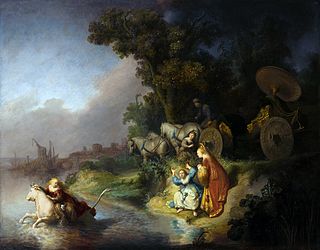 W
WRembrandt Harmenszoon van Rijn's The Abduction of Europa (1632) is one of his rare mythological subject paintings. The work is oil on a single oak panel and now located in the J. Paul Getty Museum. The inspiration for the painting is Ovid's Metamorphoses, part of which tells the tale of Zeus's seduction and capture of Europa. The painting shows a coastal scene with Europa being carried away in rough waters by a bull while her friends remain on shore with expressions of horror. Rembrandt combined his knowledge of classical literature with the interests of the patron in order to create this allegorical work. The use of an ancient myth to impart a contemporary thought and his portrayal of the scene using the High Baroque style are two strong aspects of the work.
 W
WThe Adoration of the Christ Child is a tempera and gold on panel painting by the Italian late medieval artist Gentile da Fabriano, dating from around 1420–1421 and housed in the Getty Center of Los Angeles, United States.
 W
WAllegory of Fortune, sometimes also named La Fortuna, is an oil painting on canvas, that was created around 1658 or 1659, by the Italian baroque painter Salvator Rosa, which caused uproar when first exhibited publicly and almost got the painter jailed and excommunicated. Bearing initials but undated, it measures 200.7 by 133 centimetres. Rosa was known for his landscape paintings, but also worked in the sphere of mythology, witchcraft, portraits, and satire. Since 1978 it has been in the J. Paul Getty Museum in Malibu, California.
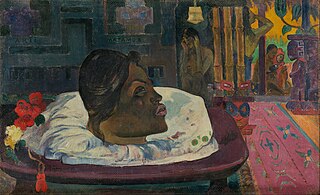 W
WArii Matamoe or The Royal End is a painting on coarse cloth by the French artist Paul Gauguin, created in 1892 during the painter's first visit to Tahiti. It depicts a man's severed head on a pillow, displayed before mourners, and although it did not depict a common or contemporary Tahitian mourning ritual, may have been inspired by the death of Pōmare V in 1891 shortly after Gauguin's arrival. A curator for the J. Paul Getty Museum suggested Gauguin likely painted the canvas "to shock Parisians" upon his expected return to the city.
 W
WBefore and After is a pair of comic paintings by British painter William Hogarth. He made two painted versions in 1730–31. The first version showed an exterior scene in a wooded glade, based on contemporary French pastoral fête galante, while a second version moved the scene indoors. Hogarth made engravings based on the second version in 1736. In each pair, based on the position and appearance of the subjects, the first painting shows the couple before and the second after sexual intercourse.
 W
WBullfight is an 1824 oil painting by Goya owned since 1992 by the J. Paul Getty Museum. When the museum bought the painting at auction in 1992, it shattered the artist's previous auction record. This piece shows in color, with precise detail, Goya’s favorite form of entertainment: the controversial contest of bullfighting.
 W
WChrist's Entry Into Brussels in 1889 is an 1888 painting by the Belgian artist James Ensor. The work, satirising Jesus' triumphal entry into Jerusalem celebrated on Palm Sunday, is considered Ensor's most famous composition and a precursor to Expressionism.
 W
WCoronation of the Virgin is a c.1420 painting by Gentile da Fabriano, now in the Getty Museum. It originated as the front of the a processional banner - the reverse showed Saint Francis Receiving the Stigmata and is now in Parma.
 W
WDanaë is a circa 1623 oil on canvas painting by the Italian artist Orazio Gentileschi. It is an example of an Italian Baroque painting and is now in the collection of the J. Paul Getty Museum.
 W
WThe Saint Hubert Altarpiece was a late 1430s altarpiece in the Chapel of St Hubert in the church of St Gudule, Brussels by Rogier van der Weyden and his studio. Its central image is lost but its side panels are thought to be The Dream of Pope Sergius and The Exhumation of St Hubert - In around 1623 Dubuisson-Aubenay recorded seeing a two-part painting in that church which matches the description of these two panels.
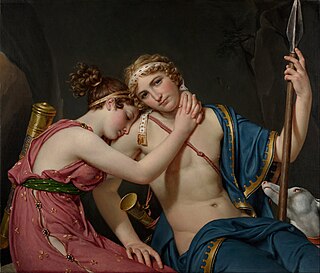 W
WThe Farewell of Telemachus and Eucharis is a painting of 1818 by Jacques-Louis David, now in the J. Paul Getty Museum. It was commissioned by Count Franz Erwein von Schonborn-Wiesentheid during David's exile in Brussels. It depicts Telemachus and Eucharis, two characters in François Fénelon's novel Les Aventures de Télémaque, inspired by Homer's Odyssey. The artist's last painting of a couple from mythology, it is a pendant painting to his Love and Psyche.
 W
WThe Grand Canal in Venice from Palazzo Flangini to Campo San Marcuola is a painting by Canaletto in the J. Paul Getty Museum in Los Angeles, California. Painted around 1738, it may have been commissioned by the English merchant and art collector Joseph Smith (1682–1770).
 W
WHead of Christ is a painting in oil on panel by the Italian Renaissance painter Correggio, dated 1521. It depicts the head of Christ, wearing the crown of thorns. In the background there is a white cloth showing that the image represents the Veil of Veronica, but Christ's head is given volume through alternate use of light and dark shadows. The painting is in the J. Paul Getty Museum in Malibu, Los Angeles. Correggio was known for creating some of the most sumptuous religious paintings of the period. The Getty Museum considers this artwork as one of the masterpieces of painting held by the museum.
 W
WInterior with an Easel, Bredgade 25 is an oil-on-canvas painted by Danish artist Vilhelm Hammershøi in 1912. Acquired by the Getty Museum in 2018, the painting depicts the artist's apartment at Bredgade 25 in Copenhagen, which was his address up to his death in 1916.
 W
WIrises is one of several paintings of irises by the Dutch artist Vincent van Gogh, and one of a series of paintings he made at the Saint Paul-de-Mausole asylum in Saint-Rémy-de-Provence, France, in the last year before his death in 1890.
 W
WThe Laundress is a 1761 genre painting by French artist Jean-Baptiste Greuze (1725-1805), existing in two versions. Its development was influenced by Dutch cabinet painting and the imagery of the laundress made popular through a literary style known as genre poissard. The prime version of The Laundress was one of fourteen works exhibited by Greuze at the Salon of 1761 and was part of the collection of Greuze's patron, Ange Laurent Lalive de Jully. The painting was mostly unknown for more than two centuries as it was purchased in 1770 by Gustaf Adolf Sparre and privately held in that Swedish art collection and rarely seen until it was acquired by the Getty Museum in 1983.
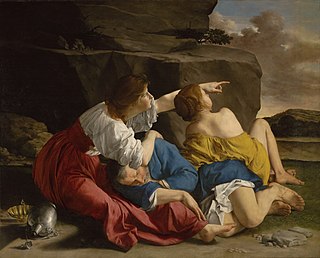 W
WLot and His Daughters is a 1622 painting by Orazio Gentileschi. Executed in oil on canvas, the large painting depicts the Biblical tale of Lot and his two daughters after the destruction of Sodom.
 W
WMadonna and Child with Two Donors is a 1533-1535 oil on canvas painting by Lorenzo Lotto, now in the J. Paul Getty Museum in Los Angeles. It and other works by the artist originated in the palazzo Pallavicini Rospigliosi collection in Rome before being sold to the Benson collection in London, then to the Hearst Corporation in New York and finally to its present owner.
 W
WModern Rome – Campo Vaccino is a landscape by British artist Joseph Mallord William Turner completed in 1839. It is Turner's final painting of Rome and had been in the possession of the family of the 5th Earl of Rosebery since 1878, until the painting came to auction, 7 July 2010. It was bought by the J. Paul Getty Museum, Los Angeles, and was subject to an export bar to allow a British gallery time to attempt to match the Getty's bid.
 W
WThe Musicians' Brawl is an oil on canvas painting by the French artist Georges de La Tour, produced at an unknown date between 1620 and 1630. Previously attributed to Caravaggio, the work was in Lord Trevor's collection by 1928. It was reattributed to de la Tour in 1958 by Charles Sterling and Francois-Georges Pariset and sold in 1972. Its present owner the J. Paul Getty Museum acquired it in 1973.
 W
WThe Pisa Altarpiece was a large multi-paneled altarpiece produced by Masaccio for the chapel of Saint Julian in the church of Santa Maria del Carmine in Pisa. The chapel was owned by the notary Giuliano di Colino, who commissioned the work on February 19, 1426 for the sum of 80 florins. Payment for the work was recorded on December 26 of that year. The altarpiece was dismantled and dispersed to various collections and museums in the 18th century, but an attempted reconstruction was made possible due to a detailed description of the work by Vasari in 1568.
 W
WPortrait of a Halberdier, The Halberdier or Man with a Halberd is a 1529-1530 or 1537 oil painting by Pontormo, originally painted on panel and later transferred to canvas. It is now in the Getty Museum in Los Angeles. A preparatory drawing now in Florence's Gabinetto dei Disegni e delle Stampe shows the figure in a more frontal and less contraposto pose.
 W
WPortrait of Alfonso d'Avalos with a Page is a 1533 portrait by Titian of Alfonso d'Avalos, a general in the service of Charles V, Holy Roman Emperor. It has been in the Getty Museum in Los Angeles since 2004. After Venus and Adonis (1555-1560) and Penitent Magdalene (1555-1561), it was the third Titian work to enter the Getty collection.
 W
WPortrait of Anne, Countess of Chesterfield is a large oil-on-canvas painting by the English portrait and landscape artist Thomas Gainsborough, completed between 1777 and 1778. It shows Anne Stanhope, wife of Philip Stanhope, 5th Earl of Chesterfield, sitting in a blue and while satin dress, sitting in a garden, and is one of the best known of Gainsborough's many portraits of English aristocrats.
 W
WThe Portrait of Isabella of Portugal is an oil-on-oak Early Netherlandish painting of Isabella of Portugal, Duchess of Burgundy, the third wife of Philip the Good. Executed around 1450, the painting had been attributed to Rogier van der Weyden, but is now believed to be from a member of his workshop.
 W
WPortrait of Jeanne Kéfer is a portrait by Fernand Khnopff, painted in 1885. Currently housed and exhibited in The J. Paul Getty Museum, Los Angeles.
 W
WPortrait of Madame Brunet is an oil painting on canvas by Édouard Manet, begun in 1861 and completed in 1863. Its subject is Caroline de Pène, the wife of the sculptor Eugène Cyrille Brunet. According to Duret the she was not beautiful and – although Manet flattered her – she burst into tears when she first saw the painting. It originally depicted the sitter full-length, but by 1867 Manet had cut away the bottom section.
 W
WLa Promenade is an oil on canvas, early Impressionist painting by the French artist Pierre-Auguste Renoir, created in 1870. The work depicts a young couple on an excursion outside of the city, walking on a path through a woodland. Influenced by the rococo revival style during the Second Empire, Renoir's La Promenade reflects the older style and themes of eighteenth-century artists like Jean-Honoré Fragonard and Jean-Antoine Watteau. The work also shows the influence of Claude Monet on Renoir's new approach to painting.
 W
WThe Rue Mosnier with Flags is an 1878 oil on canvas painting by Édouard Manet, showing the eponymous Parisian street, decorated with French flags for the first national holiday on 30 June 1878, the Fête de la Paix. The Fête de la Paix was held during that year's Exposition Universelle, which together marked France's recovery after the Franco-Prussian War and the Paris Commune. The holiday was moved to 14 July in 1880 to become Bastille Day. The painting is held by the J. Paul Getty Museum.
 W
WSaint Sebastian Thrown into the Cloaca Maxima is a 1612 oil on canvas painting by Ludovico Carracci, now in the Getty Museum in Los Angeles, which acquired it in 1971. A preparatory drawing survives in the Louvre.
 W
WSpring is a painting by Édouard Manet that was created in 1881. It debuted at the Paris Salon of 1882 and was considered the greatest and final public success of Manet's Salon career. It depicts Parisian actress Jeanne DeMarsy in a floral dress with parasol and bonnet against a background of lush foliage and blue sky, as the embodiment of Spring. The painting also became the first work of art ever to be published in color.
 W
WSpring is an 1894 oil-on-canvas painting by Lawrence Alma-Tadema, which has been in the collection of the J. Paul Getty Museum in Los Angeles, California, since 1972. The painting relates the Victorian custom of children collecting flowers on May Day back to an Ancient Roman spring festival, perhaps Cerealia or Floralia or Ambarvalia, although the details depicted in the painting do not correspond to any single Roman festival. It was the inspiration for the scene of Julius Caesar's triumphal entry into Rome in the 1934 film Cleopatra.
 W
WThe Pisa Altarpiece was a large multi-paneled altarpiece produced by Masaccio for the chapel of Saint Julian in the church of Santa Maria del Carmine in Pisa. The chapel was owned by the notary Giuliano di Colino, who commissioned the work on February 19, 1426 for the sum of 80 florins. Payment for the work was recorded on December 26 of that year. The altarpiece was dismantled and dispersed to various collections and museums in the 18th century, but an attempted reconstruction was made possible due to a detailed description of the work by Vasari in 1568.
 W
WSt. John is a painting by the Dutch Golden Age painter Frans Hals, painted in 1625 and now in the Getty Museum, Los Angeles.
 W
WStarry Night is an oil-on-canvas painting created by the Expressionist artist Edvard Munch in 1893. This night landscape represents the coastline at Åsgårdstrand, a small beach resort south of Oslo in Norway, where Edvard Munch had spent his summers since the late 1880s. In this painting Munch shows the view from the hotel window, where he fell in love for the first time.
 W
WTwo Water Mills with an Open Sluice, also known as Two Watermills and an Open Sluice, Two Undershot Water Mills with an Open Sluice is a 1653 painting by the Dutch Golden Age painter Jacob van Ruisdael. It is in the collection of the Getty Museum in Los Angeles.
 W
WA composition of Venus and Adonis by the Venetian Renaissance artist Titian has been painted a number of times, by Titian himself, by his studio assistants and by others. In all there are some thirty versions that may date from the 16th century, the nudity of Venus undoubtedly accounting for this popularity. It is unclear which of the surviving versions, if any, is the original or prime version, and a matter of debate how much involvement Titian himself had with surviving versions. There is a precise date for only one version, that in the Prado in Madrid, which is documented in correspondence between Titian and Philip II of Spain in 1554. However, this appears to be a later repetition of a composition first painted a considerable time earlier, possibly as early as the 1520s.
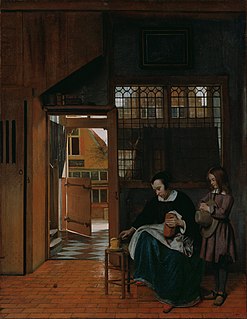 W
WA Woman Preparing Bread and Butter for a Boy (1660-1663) is an oil on canvas painting by the Dutch painter Pieter de Hooch, it is an example of Dutch Golden Age painting and is part of the collection of the Getty Center.